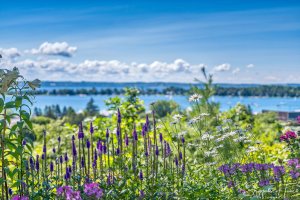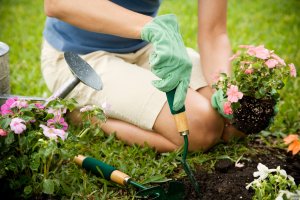Spring Phenology
April 19, 2023
Sam Volz, Park Interpreter

Spring has officially sprung! It’s easy to see the signs of spring everywhere you look. Trees are beginning to bud, birds are singing away, and life is springing up all around us. We can tell what time of year or what season it is without ever looking at a calendar. There are certain signs and natural phenomenon we can look to that tell us all we need to know. A typical harbinger of spring is the American Robin, but why?
We know that as soon as we see a chubby, red-breasted robin hunting for worms in our yard that spring is well on its way. While Robins are considered migratory birds, they don’t always travel very far, if at all throughout the year. They do tend to move around in search of food sources, one of their favorites being the earth worm. In the winter the ground is far too cold to find a juicy worm or insects, so Robins will travel in search of food. Once the season begins to shift and the ground begins to thaw, Robins will once again travel back to their chosen nesting grounds, which just may happen to be your front yard. The return of the robins are not the only known sign of spring in our region. We can also find spring ephemerals emerging from the wet soil, drumming woodpeckers, and ponds full of calls from the Chorus Frogs. As soon as the leaves begin to unfurl, we know that warmer days are ahead of us.
So, what does all this information mean and why do we care what happens when? There are those who are dedicated to the study of seasonal changes or biological life cycles, referred to as phenology. Phenology can give us an enormous amount of information about the world and just what is going on. From the first flight of a monarch butterfly to the first changing leaf on a deciduous tree, seasonal changes can be useful when looking at the effects of climate and habitat changes.
Migratory birds need to get the timing just right when traveling to and from their nesting habitats. If the travel too soon they may miss out on essential insect emergences to feed on, if they leave too late, they may not be able find suitable shelter or food sources to fatten up for a long journey. This is just one example of how wildlife need to rely on consistent natural phenomenon to survive.

Humans also rely on this consistency as well. Gardeners need to know when the last predicted frost will be before planting their fruits and vegetables. Maple syrup producers need to know when weather conditions will allow sap to be harvested before it spoils, and people with seasonal allergies may need to know when to start stocking up on allergy medication.
What would happen if suddenly, these seasonal changes shifted? Or we didn’t have the data to predict when these changes were going to occur? Well, we already are experiencing this through climate change and increasing global temperatures.
Migratory animals are arriving early or leaving late, reptiles and amphibians are emerging from their winter dormancy too soon, plants are developing at a quicker rate, resulting in earlier and shorter blooms – which will then affect those who rely on those plants for a source of food. Humans are being affected just as much as the wildlife. Longer warm seasons mean an increase in potential invasive species and pest insects such as mosquitoes, fleas, and ticks. Those who are unable to adapt to these shifts are unlikely to survive. As the Earth warms due to climate change, nature is being triggered differently than it has been before. Changes in spring phenology are becoming more apparent and variable as the years pass by. These changes will continue to happen, and the living world will continue to be affected until able to adjust accordingly.
We know there are shifts happening in these seasonal life cycles and phenomenon, but what can we do to help? Community science is a great way to assist in data collection and tracking with natural happenings. Projects such as Bud Burst, iNaturalist , Journey North and Nest Watch are a great place to start. When scientists and phenologists can gather more data, we can get a better picture of just how things are shifting and how to plan for these changes. Spring is the time for change and new beginnings, let us take a moment to appreciate and preserve the beauty of the season.
